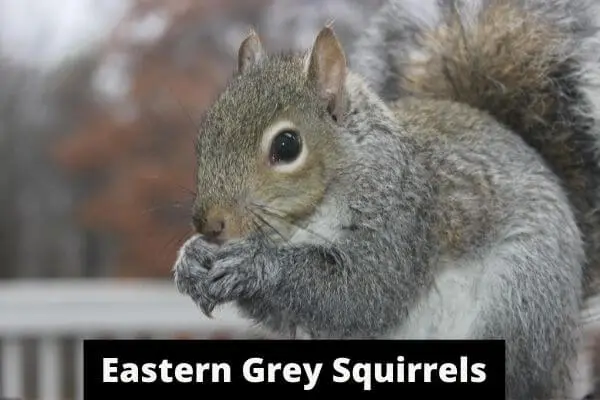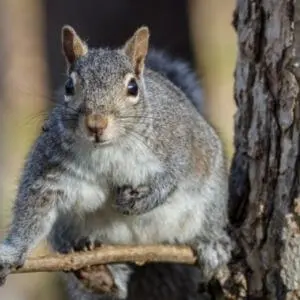Eastern Grey Squirrels Facts, Habitat, Diet & Lifespan
Did you know that grey squirrels aren’t actually from the UK? They’re from North America and were brought over in the 19th century. Grey squirrels have grey fur with red and brown patches on their face and legs, and they have long, bushy tails. They’re really good at climbing trees! But unfortunately, they’re not very good for the native red squirrels because they have a big impact on them.[acf field=”Schema”]

The long bushy tail helps them to maintain balance while climbing a tree. The colors in enough to differentiate them from other species, especially red squirrels but sometimes they have reddish grey, and greyish red squirrels occur. Still, if you get confused, to differentiate them, look at their tales. The red squirrels have uniform colors on their tail, and grey squirrels have different patches. The grey squirrel measures about 30cm in length, and the tail are around 25cm. They weigh about 600 g. The grey squirrels are medium-sized tree squirrels. The size of a male squirrel and a female squirrel is the same. They have dark grey to pale grey squirrels on their back and may have red tones. The tail is white to pale grey. The under part of grey squirrels are white, and the ears are pale grey to white.
Origin And Distribution :
Eastern grey is native to the eastern and midwestern United States. And some to the central province of southern Canada. The native range of eastern grey is overlapped and confused with fox squirrels, although the slight range is towards the west more. The eastern breeding greys are found in the region of nova scotia, but it is not known that whether this population is natural or not .the invasion of grey squirrels in the united state is known as disease-mediated invasion
DMI.
The grey squirrel was first introduced in England in 1973 in a concerted way. As the population grew, they were spread to Great Britain in the early to mid 20th century. They were introduced to continental Europe in 1948 and took advantage of habitat food sources and a non-predatory environment.
Etymology :
The generic name of the grey squirrel is Sciurus. This name is derived from two Greek words, skia meaning shadow and oura meaning tail. It means the squirrel is sitting in the shadow of its tail. In Canada and the UK, they are simply known as grey squirrels. In the US, the eastern term is used to differentiate them from western grey squirrels.
Diet :
Grey squirrels eat a variety of food such as tree bark, tree buds, flowers, seeds, acorns, walnuts, hazelnuts, some types of fungi, fruits, and vegetables. They can damage the trees by eating their soft tissues and tearing the bark. The grey squirrel often raid gardens to search corn, tomatoes, strawberries, wheat, and another garden crop. Sometimes they eat tomatoes and discard the others. Sometimes they also prey on insects, frogs, small rodents such as squirrels, birds, and bird eggs. They also sometimes bite bones, turtle shells, and antlers for the sake of minerals in their diet.
The grey squirrels have high tolerance habitat in a human residential area and raid bird feeders and sunflower seeds. Some people find it interesting and feed nuts and seeds to squirrels when they feed to birds.
Some foods that are poisonous to grey squirrels should be careful while feeding them. they include high sugar foods such as candy, cookies, sweets, high starch food, which are pasta, bread, rice
potatoes, junk foods, cashews, salt-rich food such as roasted peanuts, sunflower seeds, and dried corn,
Read More : Do Squirrels Eat Oranges
Predation :
Humans, hawks, raccoons, foxes, bobcats, feral cats, snakes, owls, dogs, and weasels are squirrel predators. In South Africa, they have been prey by AFRICAN harrier hawks.
Natural predator:
Pine martens are a natural predator of squirrels, including grey squirrels but have been eradicated from many parts of the world. The European pine martens population is expanding, and it is noticed in that area where there is an increase in pine marten population, the grey squirrel population decreases.
Reproduction :
The grey squirrel female can breed twice a year, but younger and inexperienced squirrels usually produce a single litter per year in sprong. It also depends upon the food forage and health. Older and experienced mothers may breed again in summer. If there is abundant food, 36 percent of females bear two litter per year. The breeding season is from December to February and May to June. In a northern latitude, they are slightly delayed. The first litter is born in February or March, and the second is born in June or July. The bearing may be delayed by the climate, temperature, and availability of food. If the female fails to conceive or loses it young due to cold weather or predation, it again enters the estrus and produces litter. The female, after entering the estrus, may attract 34 males from 500m away. The males will run after females for an hour before mating, and the dominant male will get the chance only. The female will mate with several males multiple times.
Usually, 1 to 4 kits are bone in a litter, but the largest size is eight kits per litter. The young kids are known as kits. The gestation period is approximately 44 days. The mother weans off their kits when they are ten weeks old and sometimes at weeks in the wild. They leave their nest at the age of 12 weeks and search for their food .normaly one out of 4 kits survive the first year of their life with mortality around 55 percent of the following year.
The eastern grey female enters the estrus as early as 5 or 5.5 months of age, but they are not fertile until the first year of their age. The estimated age of the first estrus is about 1.25 years of age. Male squirrels are sexually mature in 1 or 2 years of their age.
Life span :
The squirrels in captivity can live up to 20 years of their age, but in the wild, they live much shorter due to different challenges they face, such as habitat, food, and predators. The expected life span is to 2 years, and the young can make it to 6 years, and unexpectedly it can be up to 12 years.
Growth And Ontogeny :
The newborn grey squirrels are pink in color and are entirely hairless. The birth weight is 1 to 18 gm. The skin begins to dark after 7 to 10 days of postpartum just before juvenile pelage grows in. They open eyes at 21 to 42 days and ears at3 to 4 weeks after postpartum. The lower incisors 19 to 21 days, and upper incisors erupt after four weeks of postpartum. Cheek teeth have erupted during six weeks. The mother starts weaning at the 7th week of postpartum and is finished at ten weeks. The total mass of the body is achieved after 8 to 9 months of birth. Communication :
As in most mammals, the grey squirrels also use vocalization and posturing for communication. These species have quite different vocalizations, including a squeak like a mouse, a chatter, and a raspy Mehr Mehr Mehr. The other methods for communication include tail flickering, gestures, and facial expressions. Tail flickering is an indication to the distant squirrels about the danger they are facing and calling them for help. Also, to warn them when the predator is leaving. Squirrels also make an affectionate sound which is biologically known as muk muk sound .this sound is used by the mother to their kits and by the male during mating when he courts the female. The use of the vocal and visual signs for communication varies from area to area. For example, in a heavily dense populated area, there is noise pollution, so visual signs are used, but in woodlands, vocal signs are used for communication due to low noise pollution.
For Extra Reading: Flying Squirrel As Pet
Habitat:
The greys squirrels are found inhabiting a large dense area of ecosystem covering 100 acres of land generally. This forest has large mast-producing trees such as oaks, hickories which provide ample food sources to eastern grey squirrels. Oak-hickory hardwood forest is preferred among the coniferous trees due to the greater abundance of mast production .eatren greys are usually preferred to build their den on the dense tree branches and hollow tree trunks. Some grey squirrels also have been seen taking shelter within abandoned bird nests. They make their den with moss plants, dried grass, thistledown, and feathers. These things work as an insulator and protect the den from heat. The rest of the den is covered later.
The grey squirrels are also found in parks, house backyards, and in farmlands of the rural environment.

Behaviors:
Like other members, the eastern grey squirrels are scattered hoarders. It hordes foods for later recovery in small catches. Some caches are quite temporary and can be reached within a day or hour for reburial in a more secure site. Some caches are permanent and cannot be reached before one month. Every squirrel is estimated to build thousands of caches every season. They have spatial memories to relocate the caches, and often smell sense is used to uncover the food caches. But the scent can be unreliable when the land is covered with snow or is too dry. Squirrels also use to adopt deceptive behavior of burring food when they feel they are being watched. They do it by digging a hole as usual and mining the food in it while holding it in their mouth. They hide behind the vegetables while burring food or hide up a high tree. These behaviors are not innate and imply a theory of mind thinking. The eastern grey squirrels are among the few mammals who can descend the tree with head first. They descend it in this way because the claws of their hind paw can hold and grip the tree trunk tightly while descending. Eastern grey squirrels build their nest, which is known as a drey, from twig, moss, feathers, and dry leaves. The drey is a spherical shape. The moss, twig, and featherwork as an insulator and prevent the drey from heat. Male and female sometimes share the same nest, especially in the breeding season and during winter spills. They also stay in the den to stay warm. Squirrels also nest in exterior walls of houses where they are regarded as pest and fire hazards due to their habit of gnawing electric wires. Squirrels may permanently make a den in the hollow trunk of the trees.
Eastern grey squirrels are more active during the early and late hours of the day. They tend to stay in their den in summers to avoid heat. In winter, they do not hibernate but rest for few months in their nest to protect themselves from winter chills.
Impact on other species :
Food :
The grey squirrel as an invasive species has an introduction effect on the red squirrel population. Both grey and red squirrel compete for food resources and other resources, including habitat. The grey squirrels being in large number, forage food and clear the land before the red squirrels get chances. Also, they pilfer the red squirrel food caches. Reduction in red squirrel growth, breeding, and reproduction, and decrease population are linked with the grey squirrel. This is mainly due to that red and grey squirrels both compete for the limited resources available. Another reason for less reproduction rate is that the juvenile squirrel dies before reaching sexual maturity due to less availability of food.

For Extra Reading: Do squirrel eat meat?
Poxvirus :
In addition to resources, poxvirus is the major cause of red squirrel decline. The grey squirrel carries a virus name poxvirus which is not harmful to themselves but strong enough to kill the red squirrel. The poxvirus makes red squirrels sick, which ultimately results in their death. The virus works so fast after infecting its host, and in the end, the host dies.
Woodland and songbird species:
The grey squirrel also fed sometimes on insects, birds, and birds egg and chick. So they are also responsible for the declining population of woodland and birdsong species. The grey squirrels are blamed for this decline in the UK, but there it is not the case. They occasionally fed on insects, birds, nuts, seeds, fruits, and flowers according to availability in different seasons.
Bark Stripping :
Did you know that squirrels can sometimes do things that are not so good for the environment? One of these things is called bark stripping. This means that they take off the bark from trees, which can make the branches weaker and more likely to break. This can cause infection in the tree, which can sometimes even lead to the tree dying. Squirrels also damage trees by eating their sap. So while squirrels might be cute and fun to watch, they can sometimes have a negative impact on the trees and plants around them.
Related Posts: What do squirrels eat?
FAQS:
Q1:Should I kill grey squirrels?
According to law, it is legal to kill grey squirrels as long as it is done inhumane manners. The wildlife act 2006 states it is ill legal to cause unnecessary harm to the animals under your captivity.
Q2:What problems do red squirrels cause?
They damage maze and fruit crops and are a threat to orchards and market gardens. They destroy corns, bulbs, eat tree nuts. They also damage telephone wires and electricity cables.
Q3:What food is unhealthy for grey squirrels?
The food which is unhealthy for grey squirrels are
- High sugar foods
- High starch foods
- Salty foods
- Human junk food
- Cashews
- Pinenuts.
Related Posts:
Do squirrel eat birds
Chipmunk vs Squirrel
Baby Squirrel
Red Squirrel
